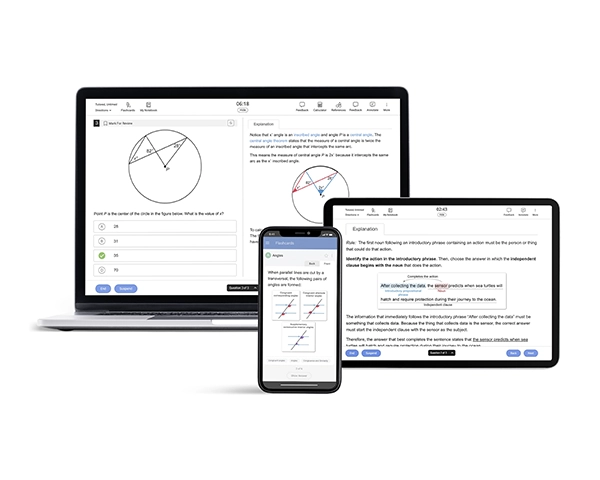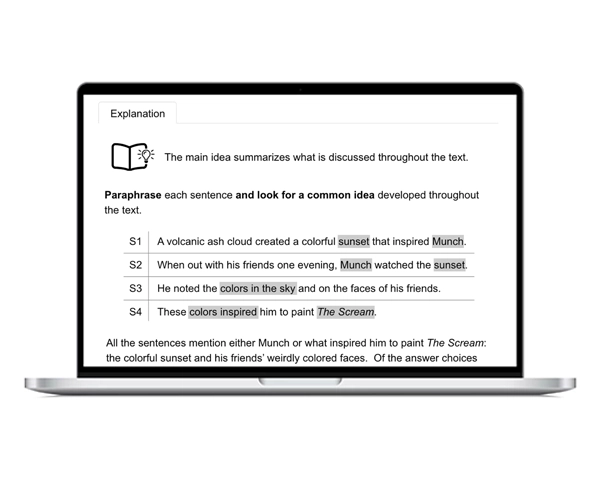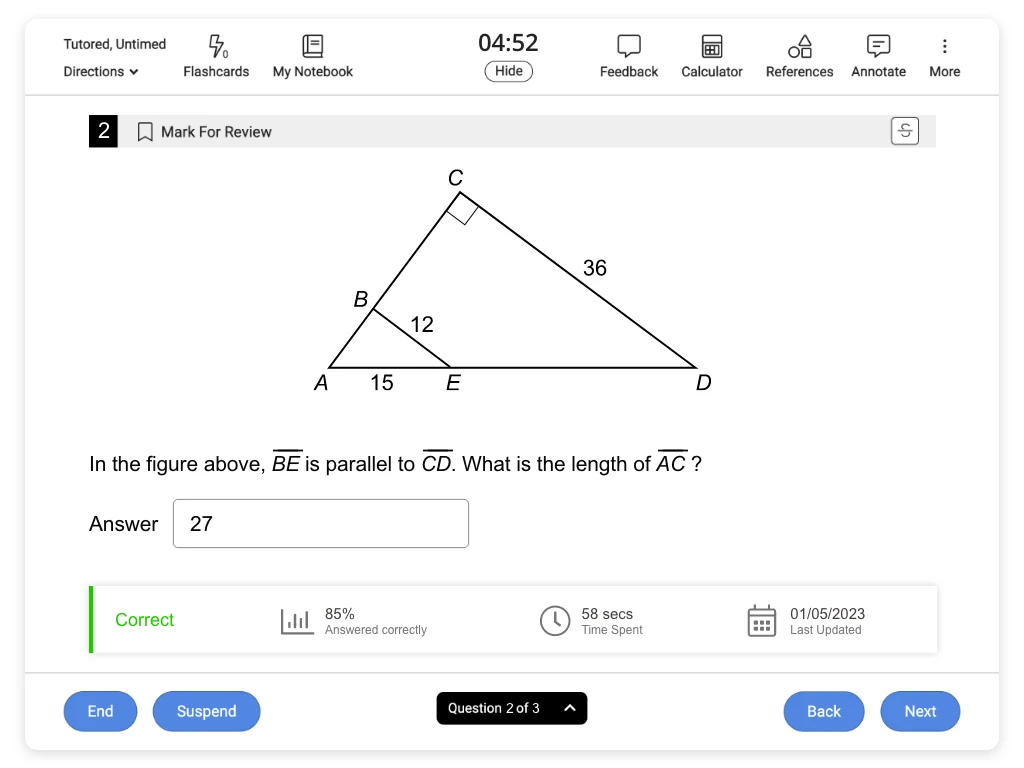What Is On The SAT®
Syllabus And Important Topics To Know

The College Board® currently administers the International SAT digitally, effective from 2023. To learn about the key changes in the new test format, check out our page on the Digital SAT.
Is the SAT Important for International students?
Yes! Taking the Digital SAT® can become the highlight of your application when applying to U.S. colleges. Here are a few reasons why the Digital SAT can be a game changer for international students:

Digital SAT Reading & Writing Section Syllabus
The Reading and Writing section of the Digital SAT will assess your college readiness in literacy. This includes your comprehension skills, vocabulary knowledge, and ability to recognize implicit meanings in sentences. It will test you based on four key domains:
-
Craft and Structure
This domain will assess skills like analysis, comprehension, reasoning, and the ability to use and understand high-utility words and phrases in context. You will also be tested on your ability to evaluate texts rhetorically and make connections between related texts.
-
Information and Ideas
Under this domain, you will be tested on your analyzing and reasoning skills and the ability to understand, interpret, and evaluate information from texts, tables, bar graphs, and line graphs.
-
Standard English Conventions
This domain measures editing skills for Standard English sentence structure, usage, and punctuation.
-
Expression of Ideas
The fourth domain tests your ability to review texts to improve written expression and meet specific rhetorical goals.
What is on the Digital SAT Reading & Writing section?
The Digital SAT RW section consists of 54 short passages with just one follow-up question, or paired question, rather than 4-5 long texts with multiple questions featured in the SAT Reading section. Each short passage potentially contains grammatical errors, such as faulty punctuation, poor word choice, incorrect sentence structure, and/or lack of proper organization. You will be asked to edit passages and eliminate errors in grammar, improve sentence structure and flow, strengthen an argument, and/or add vital information to the text. You do not need prior subject knowledge to answer these questions, but you must read carefully to avoid mistakes. To do well on this test, you need to know how words are used in context and the basics of standard English grammar and usage.
The passages in this section are targeted to measure your overall reading, comprehension, and analysis skills in different ways. We’ve listed the skills below that you will need to perform well on the Digital SAT RW section:
- Reading Comprehension
- Distinguish the main idea and supporting details
- Identify or provide evidence
- Interpret the information
- Determine the key points
- Connect the dots and make inferences
- Examine writing styles
- Determine the purpose of a detail
- Define vocabulary through difficult scenarios
- Interpret and use graphics to analyze data
Top Digital SAT Reading and Writing concepts to prepare for
There are 7 important concepts to prepare for:
- Nouns
- Pronouns
- Subject-Verb Agreement
- Verbs
- Comparisons
- Modifiers
- Parallel Structure
Check out our blog to learn more about SAT Grammar and parts of speech that may be tested in the Digital SAT Reading and Writing Section.
Keep in mind that questions covering all four content areas are included in the 54 multiple-choice questions (MCQs) in the order of Craft and Structure, Information and Ideas, followed by Standard English Conventions, and Expression of Ideas. Two pretest or field-based questions are in each module but won't be labeled separately. They're only for collecting data. Students may think they're warm-up questions, but they don't start the test sections. Treat every question the same way!

Digital SAT Math Section Syllabus
The Math section includes multiple-choice and student-produced response (SPR) questions that will measure your understanding of critical mathematical concepts and your ability to apply them. These concepts include key elements of algebra, advanced math, problem-solving and data analysis, and geometry and trigonometry.
What is on the Digital SAT Math Section
The revised Math section assesses you based on four primary mathematical topics or domains. You will be asked to create, use, interpret, or solve algebraic or mathematical equations and problems for every topic. Let’s have a look at the Digital SAT Math Test topics below:
-
Algebra
Algebra-based questions will assess your ability to analyze, solve, and create linear equations, and systems of equations.
-
Advanced Math
Advanced math questions will test your ability to understand and interpret absolute value, quadratic, exponential, polynomial, rational, radical, and other nonlinear equations.
-
Problem-Solving and Data Analysis
Problem-solving and data analysis questions will test your ability to understand and apply quantitative reasoning about ratios, rates, and proportional relationships. This domain also includes the concepts of unit rate and one-and two-variable data.
-
Geometry and Trigonometry
The fourth domain will assess you based on how you approach and solve problems on area, volume, and circles; angles, triangles, and trigonometry.
Remember that questions from all four content domains are spread across the 33 multiple-choice questions (MCQs) and 11 student-produced response (SPR) questions. Each module will include two pretest or field-based questions, but they will not be labeled separately. The pretest questions are not warm up questions, but rather are strictly used to gather data for the College Board. These questions may appear anywhere in the module and may not be the first two questions of each module, so make sure to treat each question equally.
Top Digital SAT Math concepts to prepare for
The Digital SAT Math Test topics are designed to measure your knowledge of fundamental concepts and skills. Let’s look at the concepts first:
- Algebraic concepts, which focus on linear equations and systems
- Problem-Solving and Data Analysis, both of which require you to analyze, interpret and deduce information from graphs, charts, and deduce the solution
- Advanced Math problems, which focus on nonlinear equations, exponential expressions, and word problems
- Geometry and Trigonometry
- Problems with complex numbers
These concepts require you to master specific skills essential for you to be college-ready. Let’s learn what these skills are:
- Fluency and flexibility to apply formulas and solve problems accurately and strategically
- Inspect and reorganize the information in a problem and solve it
- Demonstrate understanding of mathematical concepts, operations, and relations
- Determine the crucial elements of real-world problems, analyze those and derive a solution
We recommend you go through the concepts and skills in detail and learn how to approach the question types so nothing catches you by surprise on test day.

SAT School Day: SAT Essay
Besides the two standard sections on the Digital SAT, individuals who take the test as part of the SAT School Day program may have the choice or state-mandated requirement to complete a supplementary third section, known as the SAT Essay. Though this portion of the exam is also taken digitally in the Bluebook App, it is scored separately from the standard Digital SAT. You'll have 50 minutes to read a paragraph, identify the author's main point, and back it up with evidence on the SAT's Optional Essay test. You need to show that you understand the author's point of view by examining how the whole work is pieced together.
While you may not be required to complete the Essay portion of the test, there are a few things to remember before making your final decision. If you want to get into particular institutions, you should review their admissions policies on submitting test scores to confirm whether they factor the SAT Essay section into their decision-making. Taking the SAT Essay may also be to your advantage if you’re applying to a competitive writing-focused major, because providing a strong essay score can help your application stand out.
Conclusion: How to Use This Digital SAT Syllabus
Now that you know the topics, concepts, and what to expect on each section of the test, you can create an effective and targeted study schedule. Want help with creating a dedicated study schedule for your Digital SAT? Check out our Digital SAT Study Guide.
Knowing just the syllabus is not enough! Taking practice tests along with a dedicated study schedule is your key to Digital SAT success. UWorld’s Digital SAT Prep Course has thousands of practice problems for each SAT test covering all question types, to help you prepare confidently for the high-stakes exam. Use our performance tracking tools to see which topics and question types need the most work, and prepare smarter!
References
- The Digital SAT® Suite of Assessments Specifications Overview. (2022). satsuite.collegeboard.org. Retrieved July 2023, from
https://satsuite.collegeboard.org/media/pdf/digital-sat-test-spec-overview.pdf - How the Digital SAT Is Structured – SAT Suite | College Board. (n.d.).
https://satsuite.collegeboard.org/digital/whats-on-the-test/structure - Assessment Framework for the Digital SAT Suite. (2023, August). satsuite.collegeboard.org. Retrieved November 2023, from
https://satsuite.collegeboard.org/media/pdf/assessment-framework-for-digital-sat-suite.pdf - Spring 2024 SAT School Day Student Guide. (2023). satsuite.collegeboard.org. Retrieved December 2023, from
https://satsuite.collegeboard.org/media/pdf/sat-school-day-student-guide.pdf
Related Articles
Want to know everything about the Digital SAT test? Here’s your complete guide to the Digital SAT test—including when it is held, who can take it, why take it, etc.
Our guide to the Digital SAT test format can assist you in creating a study plan ahead of time so you don't have to cram for hours right before the test.
Having trouble getting ready for the Digital SAT? Get the most effective test-taking strategies and additional tips and tricks on how to improve your SAT score!
Want to know how each section of the Digital SAT is scored, how the overall score is calculated, and the raw score conversion? Our scoring guide has all the answers.